Are you at crossroads over which antique scale suits your interest? Or are you curious about the origin of the different designs? Well, welcome to the world this historic measurement device that predates modern civilization.
Antique scales are as symbolic as they are functional and beautiful. They signify impartiality in a complex world which is evident in the Effigy of Justice. She’s a blind lady holding a sword and a balance scale.
Knowing the difference between each type of antique scale is crucial. It’ll help you optimize the capacity of your device and make a fortune if you wish to sell.
Table of Contents
History of Antique Scales

We can trace the origin of scales to as far back as 2400BC. Countless civilizations have used it. From the Egyptian center beam to Englishman Richard Salter’s spring scales. They represent fairness and accountability in every way.
Everyone used the balancing scales – in the hospitals to size newborn babies, at the apothecary to measure spices, jewelers used them for sizing gold, postal services employed them when weighing letters, and the list goes on.
As the world evolved, the need for accurate measurements arose, leading to a constant upgrade of scales. Although there are several styles, they all follow the same principle – balance.
Modern Antique scales started from the classic Equal Arm balance scale. The 1700s saw the production of the Chinese Pocket Banjo for easy carriage. However, with the 1840s came Postal scales, which helped determine the price of sending a letter and package delivery costs.
By the 18th century, manufacturers added a spring resistance to the device. It gained popularity with Cookers and Bakers such that homemakers bought into the idea. Consequently, the platform spring scale became a regular fixture in the kitchen.
In 1976, antique scale enthusiasts formed the International Society of Antique Scale Collectors (ISASC). They aimed to preserve the principles and devices of measurement. By 1986, the organization expanded its reach to Europe and North America.
The world soon began to go digital, and so electronic scales took over in the 1940s.
You’d assume that this signified the end of the road for classic analog designs – you’re mistaken. A sense of calmness and assurance still accompanies the use of antique scales, so people still keep them as décor.
Types of Antique Scales
Even though there are a thousand designs of antique scales, everyone follows ten basic models. Each of these style suits a unique purpose.
- Equal Arm Scale
- Unequal Arm (Bismar) Scale
- Counterbalance Scale
- Steelyard Scale
- Spring Scale
- Hanging Scale
- Pendulum Scale
- Rocker Balance
- Miscellaneous Scale
The Equal Arm Scale
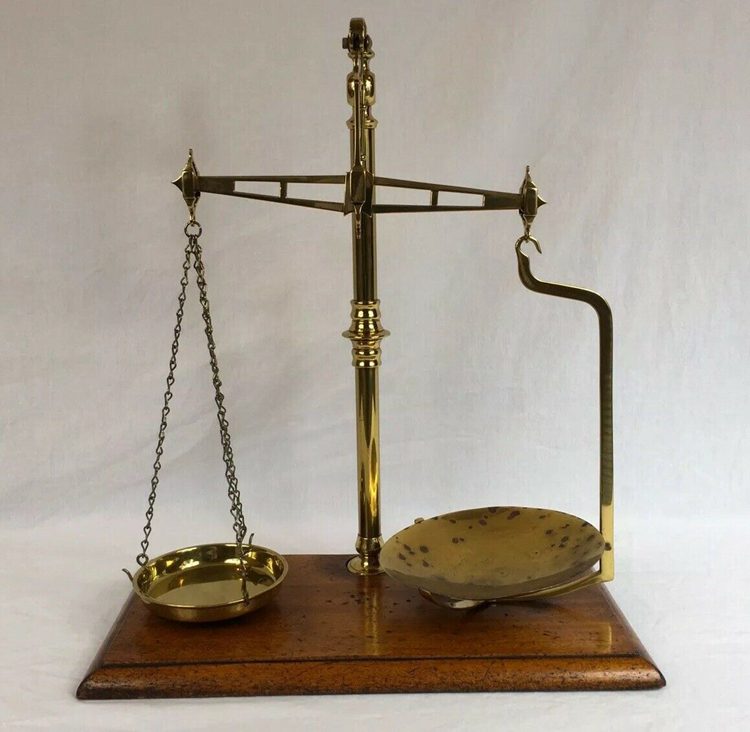
This classic style is a T-shaped device with pans hanging from each end of the horizontal line. You use it to measure unknown items against known weights. It had different sizes of apothecary weights as measurement standards.
The Romans used it to weigh gold coins, and apothecaries measured spices with theirs. But unfortunately, they’re sensitive to the slightest touch so, the owners encased them in a glass box.
Unequal Arm (Bismar) Scale
As the name implies, this device has unequal arms – one end is longer than the other.
It’s similar in some ways to the Equal Arm Scale, except that the stem doesn’t reside in the center of the horizontal line. Instead, the short end has a permanent weight that serves as the standard measurement unit.
The Postal service used this beam to measure packages and letters. You move the shaft on the opposite hook of the Bismar.
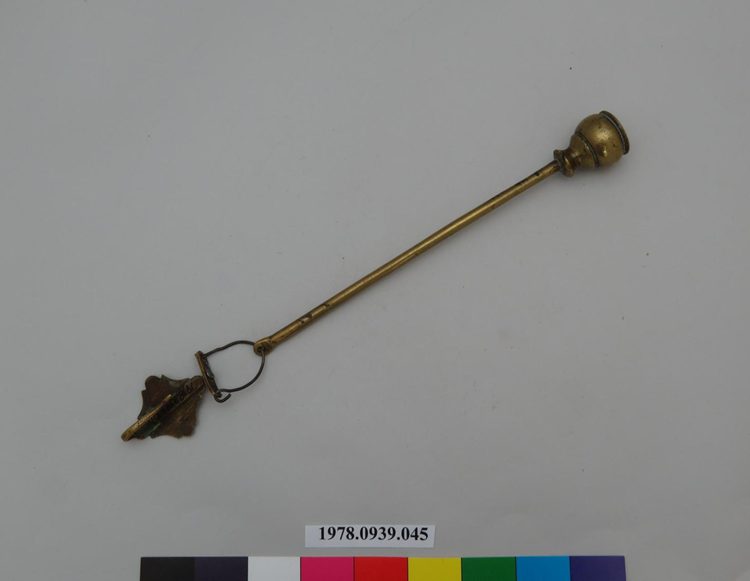
Counterbalance Scale
This gauge uses a multiplication system. First, there’s a platform that carries the load of the measured item. At the moment the load is mounted, the weight transfers to the beam that balances with a counterpoise. It was popular among veterinarians for measuring animal sizes.
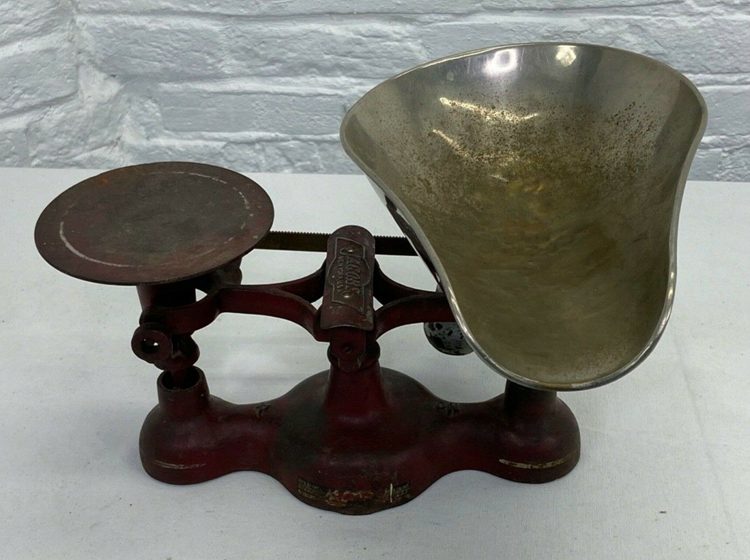
Steelyard Scale
The steelyard scale features support that hold an unequal arm beam. To use this scale, hang the item on the extended hand and keep moving it until you find a balance.
The scale was popular with butchers for measuring meat at the abattoir. The Romans also found it useful when they need to size money (gold coins in pouches.)
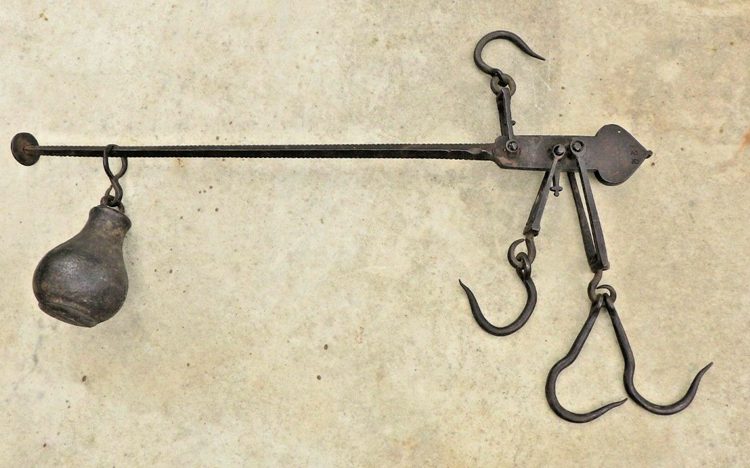
Spring Scale
You may recognize this one from your kitchen counter. It is a bowl sitting on a compressed spring scale. It consists of a gauge with a dial that moves as the load gets heavier.
The Spring Scale is an excellent accessory for your kitchen. Not only would it add a rustic style but also, it’s functional. You can use it to measure foodstuffs like meat, fruits, and fish.
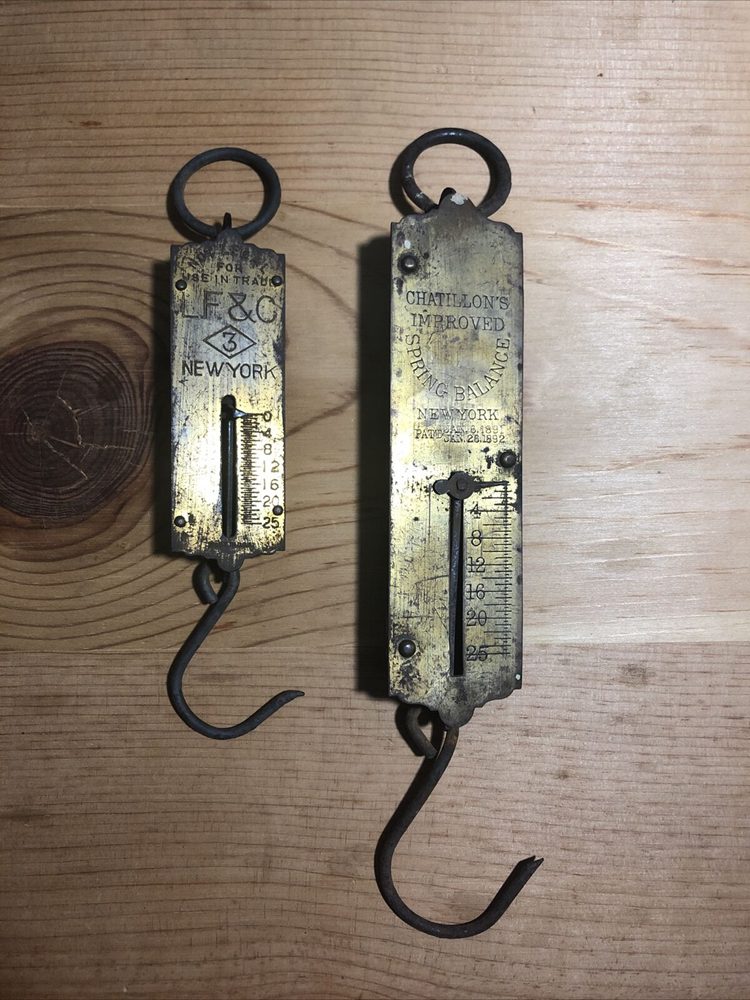
Hanging Scale
This style is similar to the Spring scale because it uses the same principle but in reverse. It’s a wall-mounted device with a dial and spring hanging from a hook. To measure an item, place the it on the hook, then the weight pulls the spring causing the indicator to move.
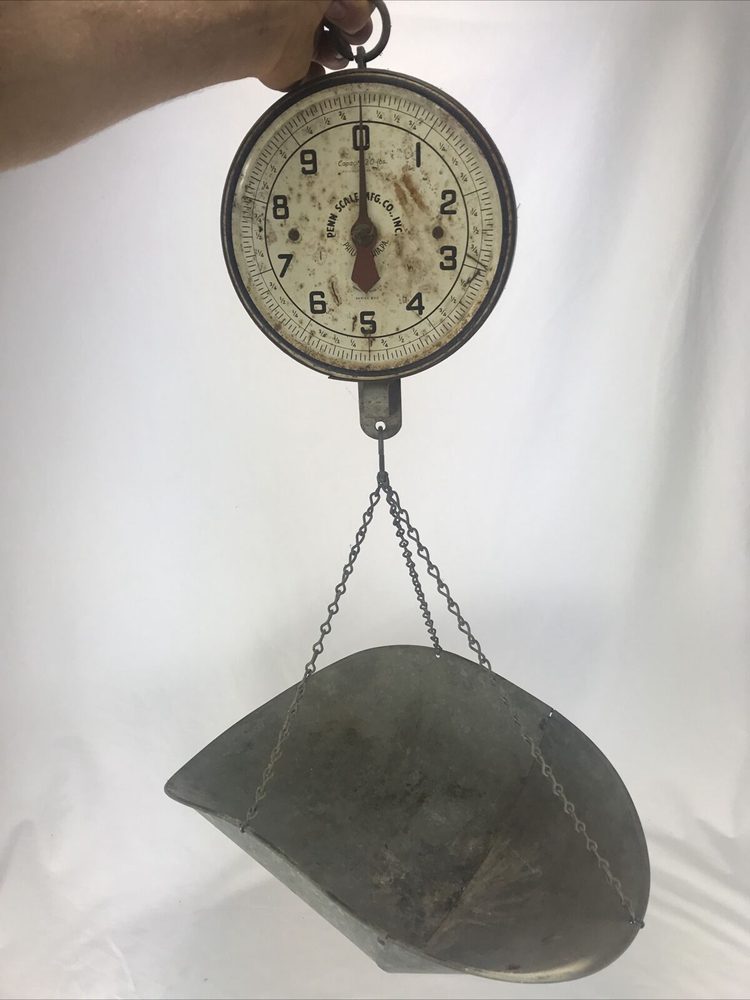
Balance Scale
Unlike the weighing scale, a Balance Scale measures unknown mass against known mass. This device has an assay beam holding two pans on either end. Scientists still use scales with this design in the lab for professional measurements.
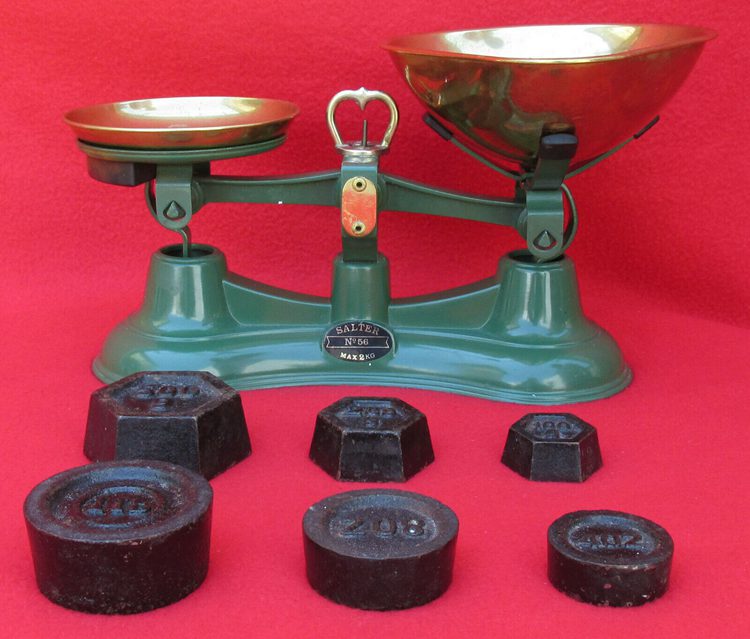
Pendulum Scale
The pendulum scales like the name implies relies on the balance of a swinging pendulum. It features a stationary vertical point, so it moves towards a horizontal level as the weight increases.
This scale is great for measuring counterweight without springs and you’ll find it in science departments at universities or laboratories.
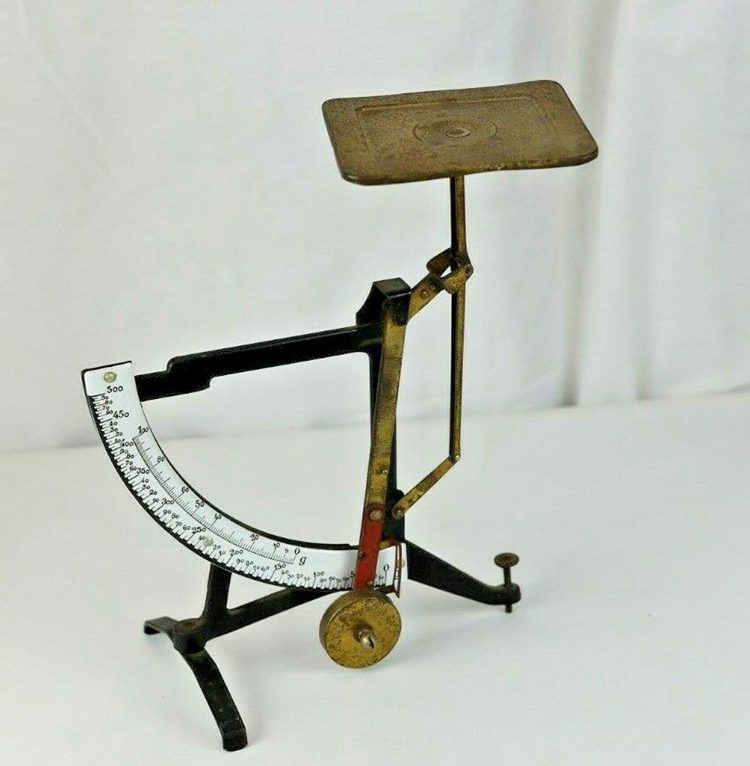
Rocker Balance Scale
This device was invented in 1817 to measure diameter and thickness. It’s like the classic equal scale with two pans hanging from a beam. You place your items inside each pan to compare the weight.
The horizontal line is a lever that moves up and down based on the weight pulling it on each side. It’s an ideal design to teach children about mass and weight. You’ll see modern variations in elementary and middle schools.
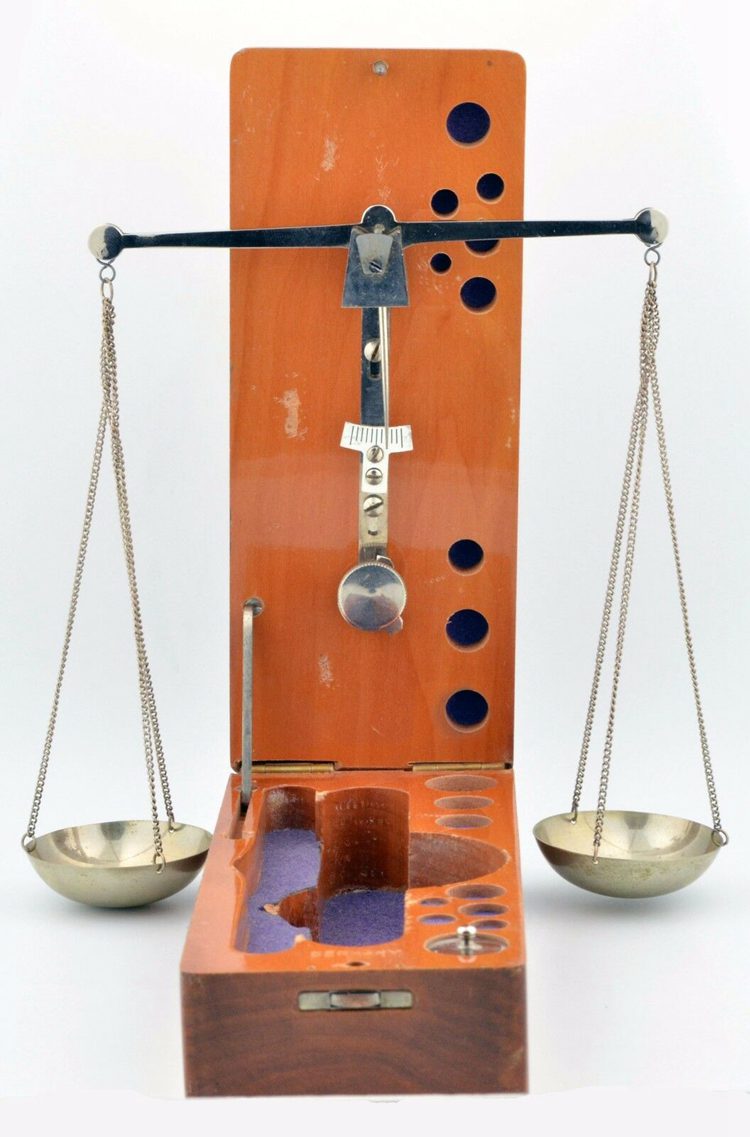
Miscellaneous Scale (MISC.)
This design doesn’t fit any of the types mentioned earlier hence the categorization in miscellaneous. However, it’s often a combination of two general categories to form one complex style. One of them is the Weight Collecting scale of 1840 by John & Edmund Ratcliff.
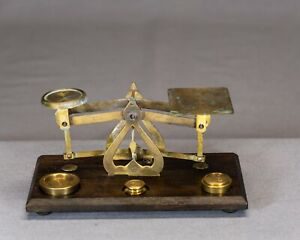
Innovators fashioned the modern weighing scale after this model. For an in-depth tutorial on antique scales, visit the ISASC website.
Identification of Antique Scale
There are standard principles to apply when assessing an antique item. The things to consider are material type, design, and rarity.
Material
Materials tell a story and take us on a journey through time. Take the iPhone, for instance; each series tells you the year of production because it upgrades almost every year. It’s the same with antiques – each material is unique to an era.
The classic Equal Arm scales have wooden supports made from mahogany or oak. The measuring pans are made from Brass, Silver, or Gold. In addition, look out for handcrafted designs and assembly.
Plastic designs are modern variants of the antique scale.
Aging
Now that you know how to identify the materials used in making antique scales, the next identification step is looking for signs of aging. Antiques were built to stand the test of time, yet they can’t avoid little tell tales.
First, you need to know that wood misshapes over the years as a reaction to the weather. So, you’ll see a chip here and a nick there. Also, it’s most likely shrunken from moisture.
Next, the pans would have scratches from moving too much. There may be a shine from polishing, but that devalues the item. You can also look for rusts along the hanging chains.
Design
With so many styles of antique scale, you should know each one is evident of its era.
Equal Arm scales are the oldest and can be traced back to 2400BC. Chinese Pocket Banjo, Spring scales, Unequal Arm Scales are from the 18th century.
The 19th century bore the Postal and Rocker Balance scale, while the 20th century ushered in the digital scale.
Rarity
The selling point of antique items is the rarity. If the scale you’re buying has multiple exact copies, it’s most likely not an antique. So be at alert. This once again takes us back to the material – ancient materials are scarce.
How to Value an Antique Scale
Just as there’s no uniform design of antique scales, there are no uniform prices. Unique factors influence the value of a relic. They are – material, age, a rarity.
High-quality materials are the most expensive because they cost so much during their time. You’ll pay about $200-$400 more for encased scales because antique glasses are rare. Food scales are pretty standard, so they cost about $40 or less.
You can contact the International Society for Antique Scale Collectors (ISASC) for an appraisal. It’ll cost you $10 only.
Final Thoughts
The same way you can’t hide smoke, you can’t fool a trained eye. Antique scales carry natural signatures that are hard to replicate. As a collector, updating your knowledge of history puts you two steps ahead.
When you know the origin of an item, it’ll be easy to note oddities. Here are three things you must never forget when examining an antique scale. They include; material, age, and rarity.
- Materials carry the signature of a period in the evolution of your antique device
- Older materials are often more expensive than recent ones.
- Rare items stay atop the food chain. The more elusive a design is, the higher the value.






![Vintage Schwinn Bikes: [Types, Identification, and Values]](https://www.txantiquemall.com/wp-content/uploads/2022/05/5.-Schwinn-1967-Ramshorn-Fastback-Stingray-Sky-Blue-vtg-600x450.jpg)
